Medical Guardian Alert Systems: Cost, Features, and More
Medical Guardian has five alert systems. Here’s why the MGMove smartwatch is our favorite.
SafeHome.org may receive compensation from some providers listed on this page. Learn More
We may receive compensation from some providers listed on this page. Learn More
Medical Guardian has five alert systems. Here’s why the MGMove smartwatch is our favorite.
For people who live alone, are prone to falling, or have a medical condition, a medical alert system or personal emergency response system can provide the best assistance in an emergency. A big misconception is that only older adults need medical alert systems, but that’s not entirely true.
Medical alert systems not only lessen anxiety and fear, but they are also linked to a reduced risk of hospitalization. If you live alone, you’re worried about your well-being, or you know someone who may benefit from a medical alert system such as Medical Guardian, we’re here to help. In this article, we’ll go over Medical Guardian pricing, plans, and features, as well as what systems are ideal for certain people based on their lifestyles.
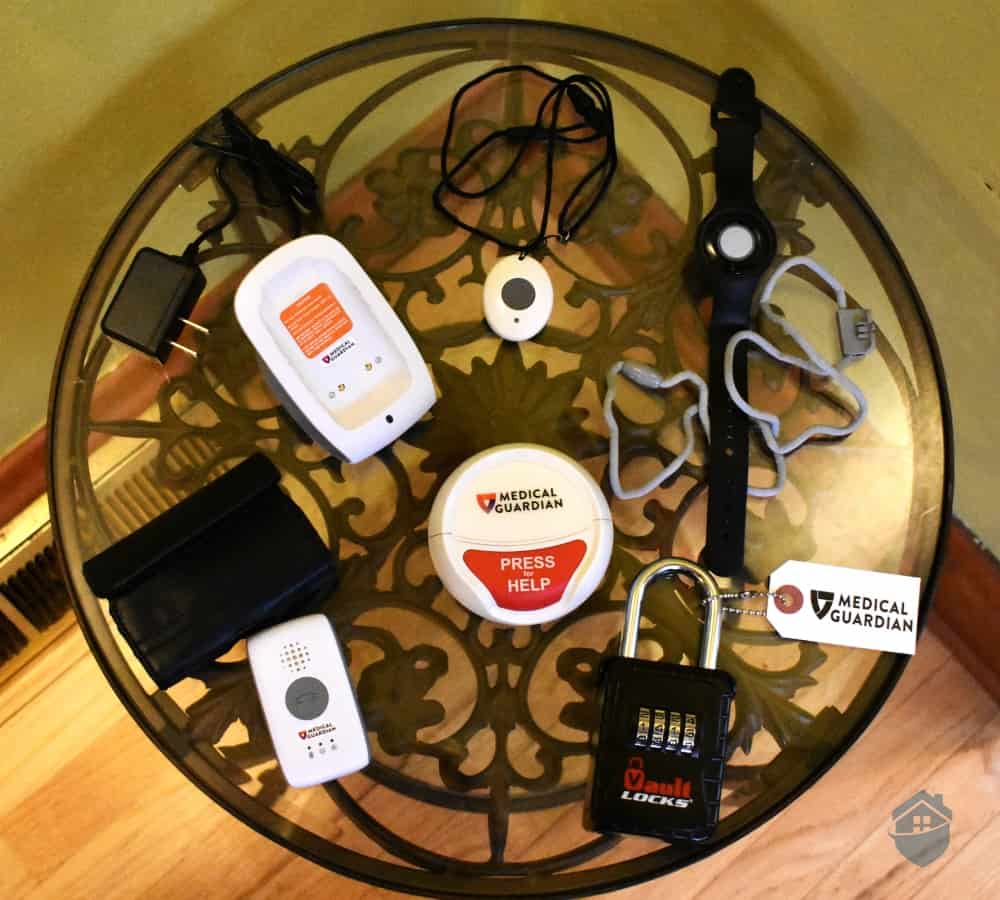
Medical Guardian
Pro Tip: You can take the Medical Guardian quiz directly on the company’s homepage to find out quickly which system and level of protection are best for you.
Buying Medical Guardian products is probably one of the easiest purchases we’ve made this month. Just the other day, for example, it took us hours to sign up for a gym membership. Safe to say we did not feel like working out afterward — we actually just went home.
Medical Guardian, on the other hand, is incredibly straightforward. All the products are listed on the company’s homepage. Once you click on one, you’ll know exactly what’s included and how much it costs. Some other products require you to sign up for an account or enter a lot of information to see pricing.

Medical Guardian homepage product options
There’s even a product quiz option in case you’re confused about where to start. We’re not sure about you, but we love quizzes.
Similar to our buying experience, installing our Medical Guardian systems was a cinch. We ordered the MGHome 2.0, the MGMini, and the MGMove. Each came in sleek packaging that made us feel like we had ordered Apple products and not medical alert systems.
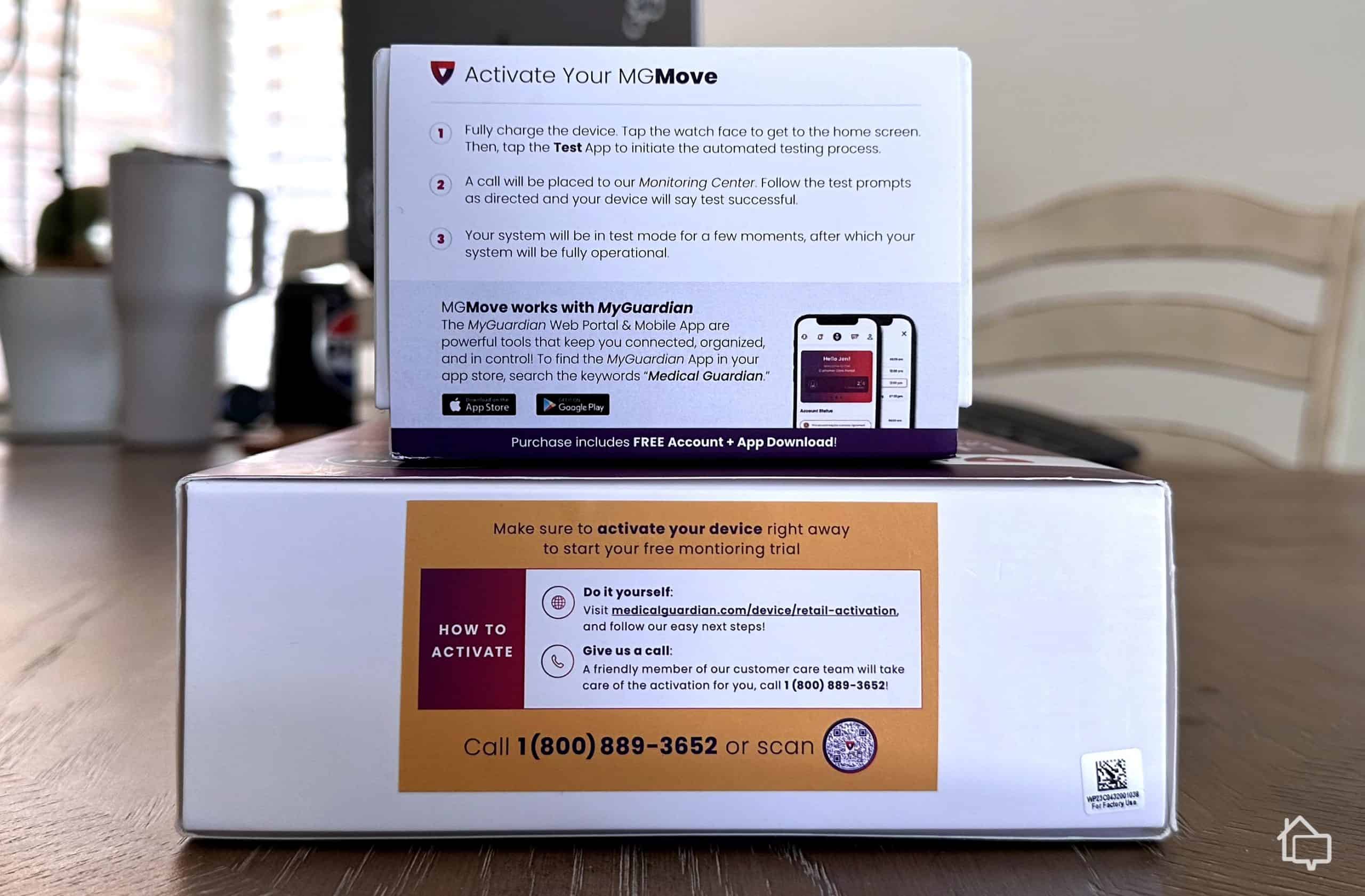
My Guardian product boxes
Every Medical Guardian product box comes with very clear and simple instructions. The company offers two ways to set up its products, and we, of course, had to try both.
When we did it ourselves online, the setup took a few minutes. We entered our information, our product UDI number, and payment information (for our subscription). To get to the setup portal online, you can scan a QR code on the box or enter the URL on your browser.
When we called, we were helped almost immediately. We were grateful for that because waiting on hold is not one of our strong suits. The setup process was similar, but we had someone on the other end of the line doing it for us.
Another thing we liked was that we never had to do anything to pair or view all our devices online. After setting up the first device, our information appeared automatically in our account. We were also able to monitor every device on the MyGuardian app, but we’ll get into that in a bit.
Historically, Medical Guardian devices have ranged from $29 to $45 per month. Probably due to inflation, its cheapest monthly subscription now starts at $32.95 for the MGClassic. We find it to be a fair price for around-the-clock emergency services.
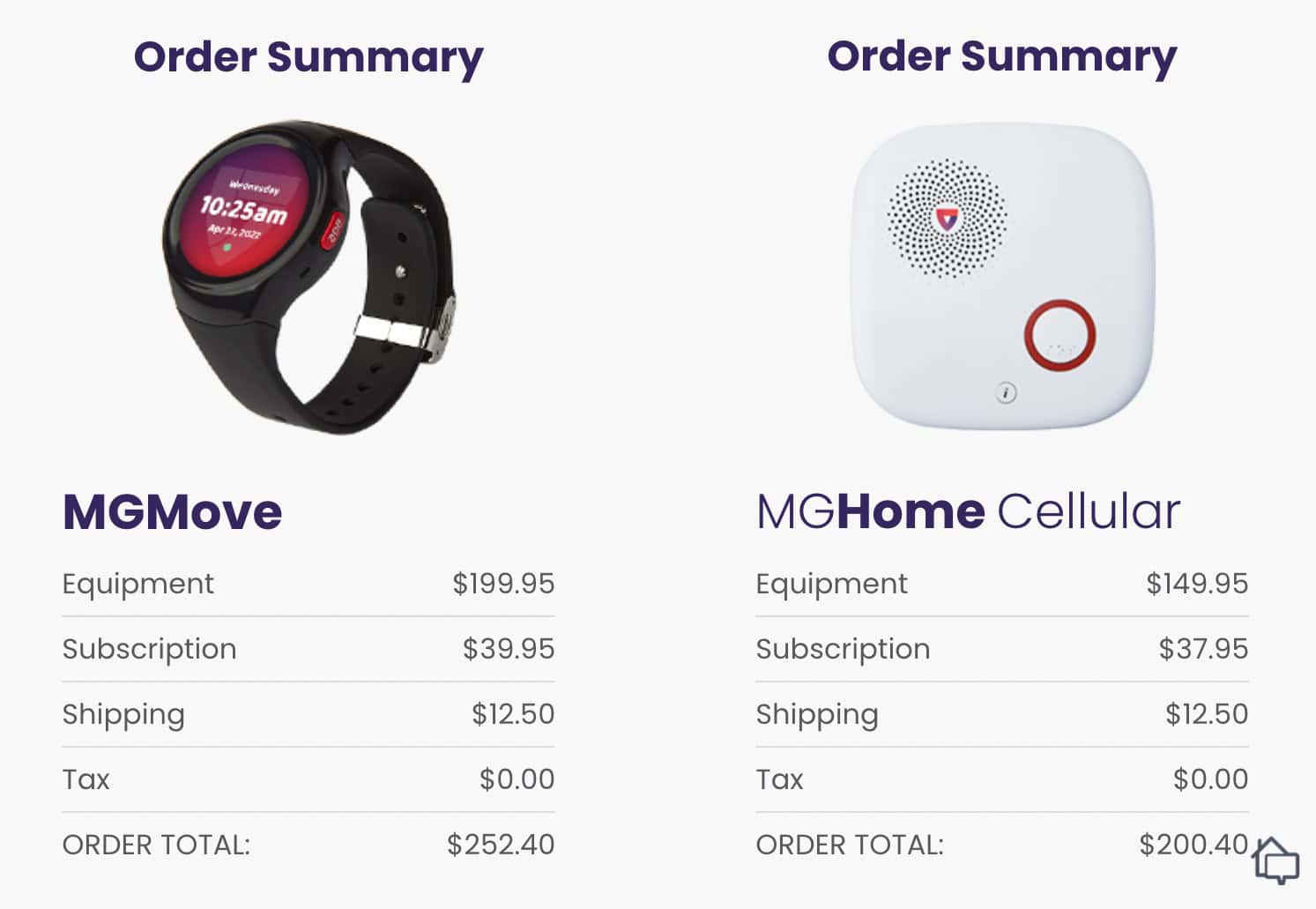
MGMove and MGHome Cellular order summary
Medical Guardian offers discounted rates if you pay annually. For the MGClassic, for example, you’d pay $362.45 up front for a year, which is $30.20 per month. If you do the math — don’t worry, we did it for you — that’s a savings of $32.95. In other words, you get one free month.
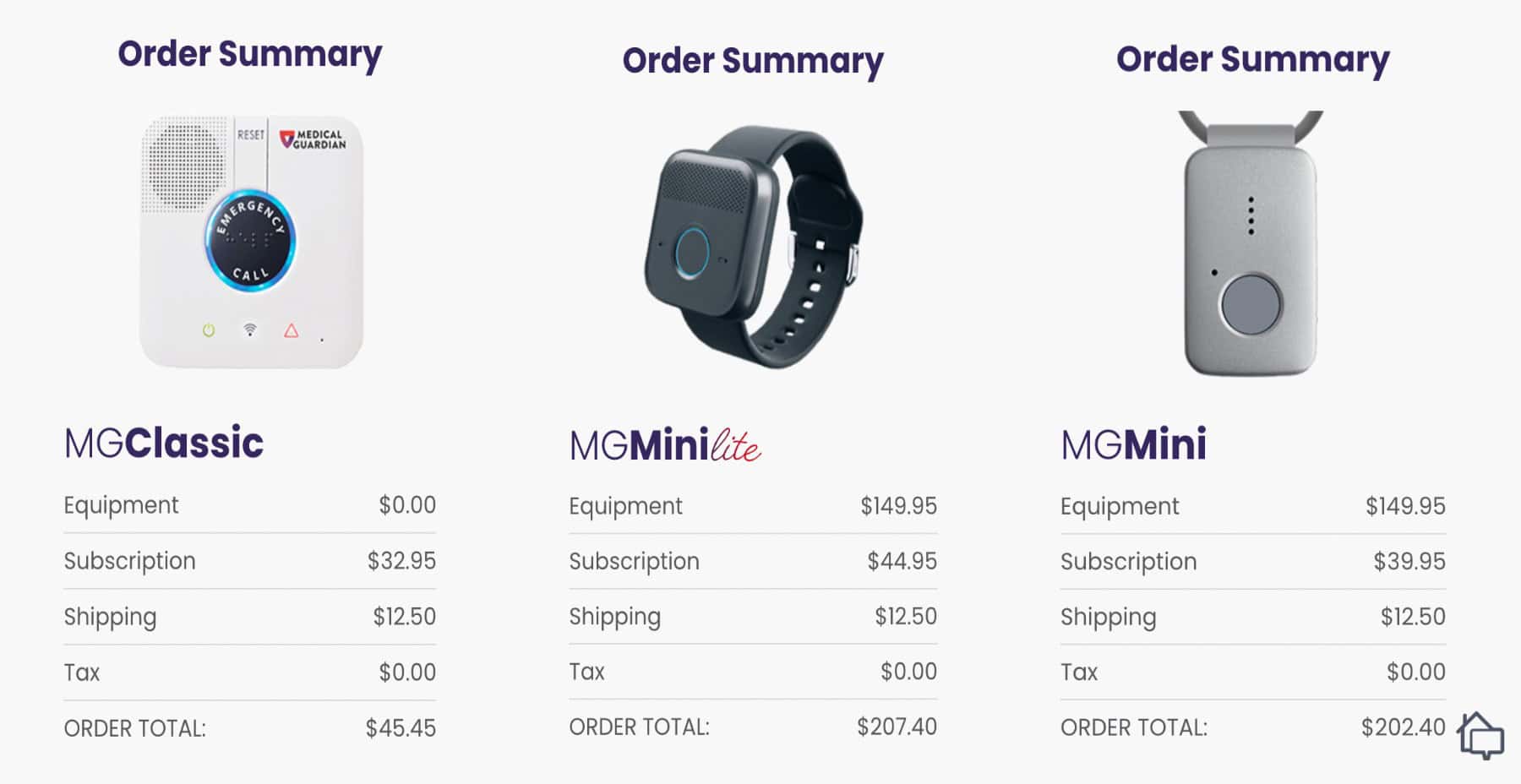
MGMini, MGMini Lite, and MGClassic order summary
One thing we liked is that there are no setup or activation fees. There is a one-time equipment fee, but that’s just buying the device itself. Standard shipping starts at $12.50, which will get you your device in seven to 10 business days. You can get it the next day for $25, overnight on a weekday for $35, or overnight on a weekend for $45.
| Medical Guardian alert systems | System type | Connection type | Monthly plan cost | Equipment fees |
|---|---|---|---|---|
| MGClassic | At-home/landline | Landline | $32.95 | $0 |
| MGHome Cellular (Home 2.0) | At-home/wireless | Cellular | $37.95 | $149.95 |
| MGMini | Mobile/wireless | Cellular | $39.95 | $149.95 |
| MGMini Lite | Mobile/wireless | On-the-go | $44.95 | $149.95 |
| MGMove | Mobile/wireless | On-the-go | $39.95 | $199.95 |
Pro Tip: Check out our list of the best medical alert systems to compare Medical Guardian against some of the most well-known brands in the industry.
Medical Guardian devices are similar in safety features. They all have access to support 24/7 and have an incredible range, but there are a few differences among devices. Below are a few things that are unique to each system.
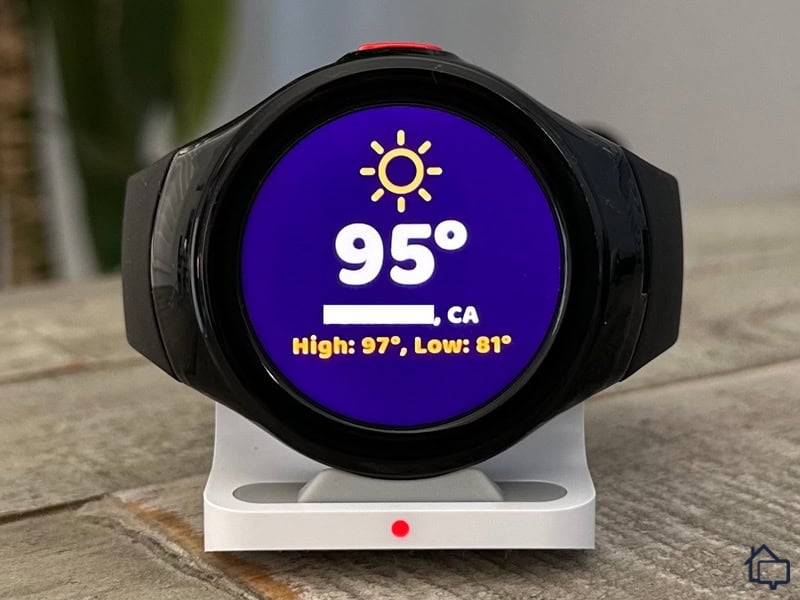
MGMove
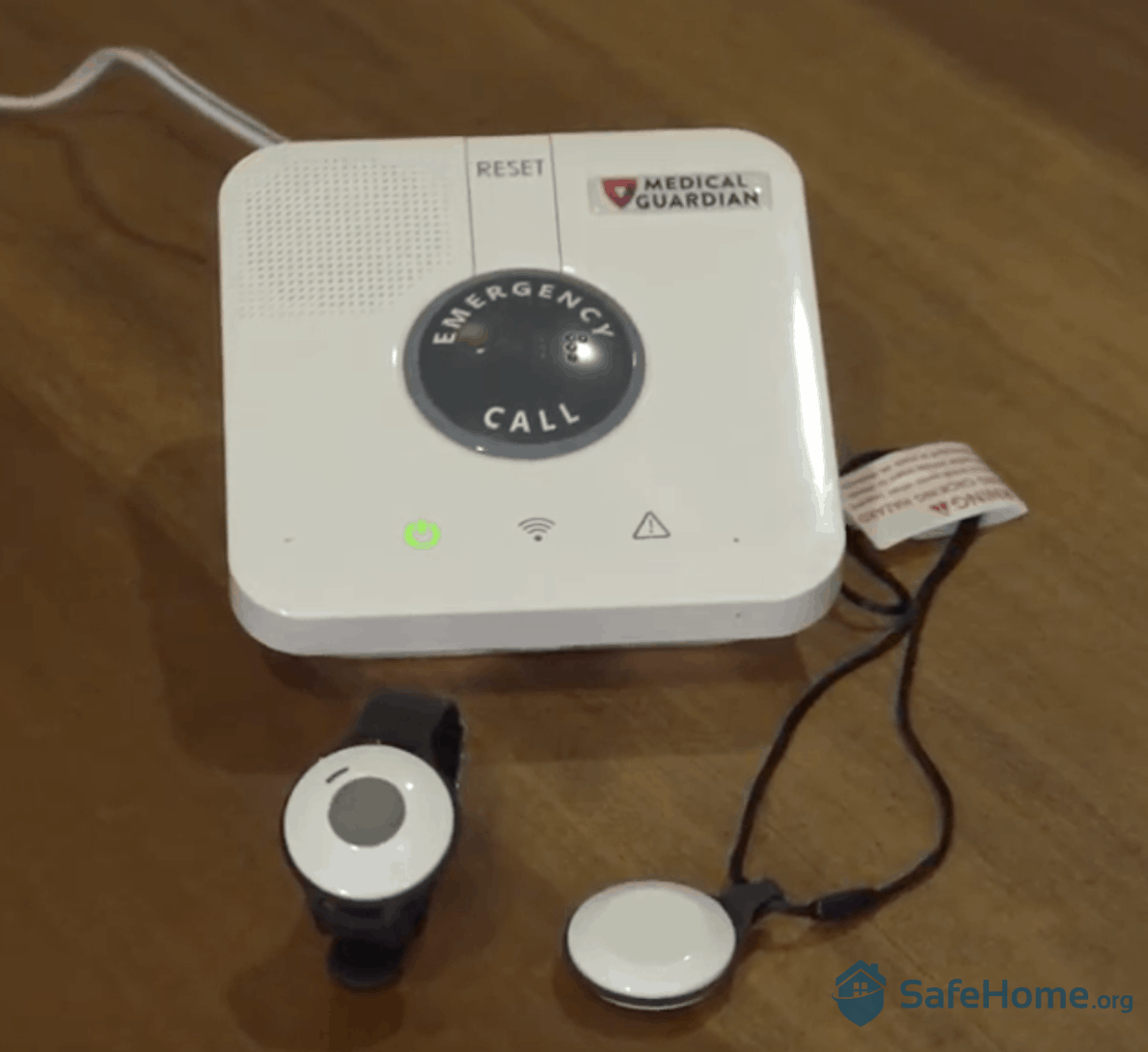
Classic Guardian from Medical Guardian
In addition to those unique features, each system comes with the option to add features and equipment. More on that below!
Pro Tip: Use our medical alert system buying guide to find out what you should be looking for in a device. We’ll tell you the features to consider, average cost breakdowns, company reviews, and equipment on the market.
| Add-on equipment | Cost | Features and functionality |
|---|---|---|
| MG protection plan | $6.99 per month |
|
| Elite 911 | $9.99 per month |
|
| Entryway lockbox for keys | $2.99 per month |
|
| OnGuard alerts | $2.99 per month |
|
| Support circle apps | $5 per month |
|
| Fall detection | $10 per month |
|
| Wireless wall button | $2.99 per month |
|
| Voice-activated wall button | $5 per month |
|
| Additional alert pendants | $2.99 per month (each) |
|
All Medical Guardian systems have access to the MyGuardian app. Using the app is incredibly easy and intuitive. It’s specifically designed with seniors in mind — there’s no small text, weird verbiage, or an overwhelming amount of options. The app’s functions are already well organized, but it also allows users to organize how they monitor their plans.
If you have more than one system, you’ll be presented with a list of all your enrolled devices when you open the app. Depending on the system you have, the features may differ slightly. When we open our MGMove dashboard, for example, we have access to system status, location, activities and reminders, and health stats. Our MGHome 2.0 dashboard, on the other hand, gives us access to our system status, location, and reminders.
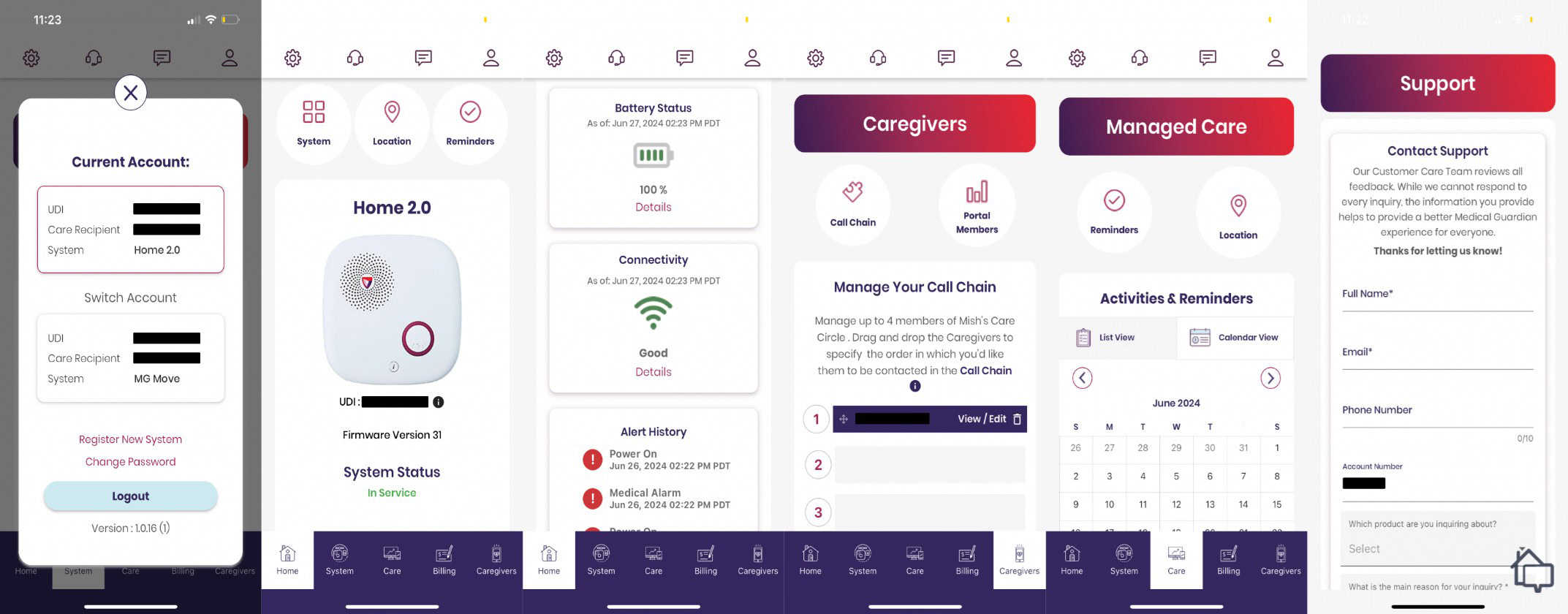
MyGuardian app
Getting help from customer service and reviewing your billing statements is also straightforward. No matter which system you have, you can make payments, change your payment method, set up autopay, and add additional features directly in the app. You can also save emergency medical information in case first responders need access to new health updates. We honestly have no complaints when it comes to the MyGuardian app.
Medical Guardian usually offers deals themed around holidays or seasons. At the time of this writing, Medical Guardian is offering 50 percent off its MGMini and MGMini Lite systems for summer. Simply enter the code SPLASH50 at checkout or call the company to redeem the offer.
The deal also comes with one free month of service, free standard shipping, and a lockbox (see details below). By the time you read this, the deal may be altered or over, but we still recommend checking the Medical Guardian website for new deals.
| MGMini | MGMini Lite | |
|---|---|---|
| Deal and perks | 50% off, plus a free month of service, shipping, and lockbox* | 50% off, plus a free month of service, shipping, and lockbox* |
| Services | Cellular/landline | Cellular/landline |
| Equipment | Wearable medical alert button | Wearable medical alert button |
| Options and add-ons* | The deal comes with a free lockbox for annual subscriptions and new customers only | The deal comes with a free lockbox for annual subscriptions and new customers only |
Still having trouble deciding which device is best for you? Let’s break it down even further.
We recommend on-the-go medical alert systems for people who are constantly on the move. If you’re mobile, active, and are always out and about, these devices are best for you. Additionally, those who have a medical condition or are prone to falling can also benefit greatly from a mobile device, since it’s always on their person.
At-home medical alert systems are best for homebodies. If you enjoy hobbies and activities at home, this type of system may be best for you. A stationary device is probably more than enough if you’re not prone to falls or have any debilitating medical concerns. For non-seniors living alone who may want some peace of mind, a basic at-home alert system could be worth the investment.
Medical alert systems are essential devices that help people in emergency situations. The market leans heavily toward seniors — and for good reason — but emergency response systems can be beneficial for people of all ages. The devices provide assistance when no one else is around or when you can’t make it to the phone in time. We see the systems as valuable pieces of equipment that provide peace of mind for people who live alone, have medical conditions, are prone to falls, or just want to feel safe running errands.
Medical Guardian offers five systems, including both on-the-go and at-home devices. Medical alert systems not only help you when you need them most, but they also greatly reduce the risk of hospitalization. We recommend Medical Guardian to anyone looking for top-of-the-line safety features, easy installation, 24/7 support, an intuitive app and online portal, and affordable plans.
When your Medical Guardian device is activated, you will be routed to an agent (human or automated) who will assess the type of help you need. If you need emergency services, they will be dispatched for you. The best part? Responders will also be given all the medical history you provided so they know how best to handle the situation. If you have any emergency contacts, they will also be notified. Users also have the option to get help directly from their contacts.
Most medical alert systems are not covered by health insurance, but it varies depending on your provider. Some plans may fully or partially reimburse you for the cost of a device.
Medical Guardian has a free manufacturer’s warranty that is active as long as you have a subscription.
Response times for Medical Guardian vary, but they’re typically between 20 and 50 seconds. We tested it several times, and we got an average response time of 23 seconds.
Yes, if you require emergency help they will call 911 on your behalf and dispatch the necessary help.